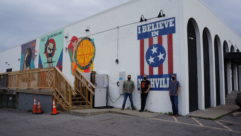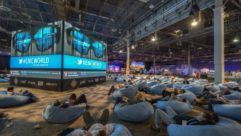Flying toward success
Jul 20, 1996 12:00 PM,
Julie Clark
At Boeing’s training center, audio, video, computer and control systems are seamlessly blended to create an ideal mode for learning.
The Boeing Company is a world leader in a highly advanced technology, the design and manufacture of sophisticated aircraft, so it should hardly come as a surprise that it exercised this technical sophistication in the development of a new Customer Services Training Center (CSTC) at its Longacres Park complex in Renton, WA. The 600,000 ft2 (55,742 m2) training facility is world-class in every sense of the word and is intended to be the most optimum environment for the education of aircraft engineers, mechanics and pilots.
A portion of the CSTC comprises 41 classrooms, several conference rooms and the T.A. Wilson Conference Center. All rooms feature some of the latest in multimedia technology; audio, video, computer and control systems are seamlessly blended to create an ideal mode for learning.
Planning for the CSTC began more than four years ago. During this initial evaluation and design phase, Electronic Image Systems (EIS) was brought on board. EIS worked closely with the client through full implementation of the multimedia systems for the classrooms, conference rooms and conference center.
With offices in Bellevue, WA, and Portland, OR, EIS specializes in supplying complete design and construction services of presentation and training facilities. In addition to its work with Boeing, EIS has completed projects for Microsoft, McCaw Wireless Data, In Focus Systems and many others.
For the Boeing project, a prototype classroom was built within the previous training center. The prototype allowed EIS and Boeing to evaluate all technologies and devices being considered, including projection devices and control systems, and propelled the design phase to the point where all objectives were fully met.
“The Boeing customer training group, and especially its director, is a technology advocate,” said Michael A. Clark, president of EIS. “Thus a driving force from the top helped to make this entire project happen to the high level that it did.”
Component selectionWith the design team assembled, attention turned to the system and its components. Each component was carefully considered; overall performance was a prime consideration, as were functionality and reliability. Certain components met all of these criteria. Other facets took more research and evaluation.
Another priority extended beyond simply putting together the latest and greatest audio, video and multimedia equipment. The design team wanted to make the systems at the CSTC as flexible as possible, especially addressing the facet of efficiently and cost-effectively updating older technology once it reaches obsolescence.
This concept stretched all the way down to the type of signal cables to be used and where they would be routed. For example, cables that could accommodate an LCD panel instead of a CRT projector were specified, and routing was done to locations where cable could easily be intercepted and other devices added to the loop.
Boeing officials joined EIS at a number of trade shows during this process to perform hands-on evaluation of products and technologies. Clark noted that this close relationship not only assisted in achieving optimum results, but it also eliminated several steps that can typically slow projects of this type, such as getting equipment requisition approval and the need for multiple product demonstrations.
Systems for all rooms at the CSTC put control of a myriad of devices at the fingertips of the class session leader at the front podium. This control, provided by Crestron Crestnet II modular and integrated control systems with LCD touch panels, is convenient, user-friendly and helpful in reaping maximum benefit from all devices, fully enhancing and speeding the learning experience rather than detracting from it.
An elaborate learning centerThe T.A. Wilson Conference Center is the largest and most elaborate room at the CSTC. It can accommodate groups of up to 400, generally made up of representatives from major airlines. The room is open and pleasant, with clear sightlines at every seat.
Tables in the conference center include a microphone for every two people. Extra consideration was given to this aspect of the design. “It’s common in designs of this type to provide a mix-minus situation, where each table has a miniature loudspeaker receiving the audio feed,” Clark said. “The loudspeaker deactivates when its accompanying microphone is activated. It was agreed this approach would be cumbersome in this project.”
Instead, the design team wanted ceiling reinforcement loudspeakers to provide the audio feed, in addition to two front reinforcement loudspeakers. Levels could be kept even throughout the room, and the person talking would not be subject to the confusion of the personal loudspeaker suddenly shutting off.
EIS devised a custom base for each Crown LM-300 dual gooseneck microphone with a backlit button linked via twisted pair to the control system feeding the LCD control panel at the podium. When the button is pushed, indicating that the talker would like to make a contribution, it is indicated on the control panel. The moderator can then activate the microphone via the panel. After the talker is done, the moderator can clear the activation and move on with another touch of the panel.
Clark said 73 Crown LM-300 condenser microphones were selected because they offer a supercardioid pickup pattern that rejects background noise and reverb and eliminates the potential for feedback, key to a design with loudspeakers constantly open. The microphones include a balanced, low-impedance connector that allows long cable runs without hum pickup or high-frequency loss.
Both TOA automatic microphone mixers and pre-amplifiers are used, with a Mackie 1604 console providing extra mix capability when needed. Bose model 102F recessed ceiling loudspeakers are distributed overhead, with two JBL Control 10 theater loudspeakers mounted on the left and right on the front wall on pivoting brackets. And all of these loudspeakers are driven by the Com-Tech series power amplifiers from Crown.
Unlimited routingA control booth at the rear of the conference center houses the Crestron control mainframe, another LCD touch panel providing system operator access, high-intensity slide projectors and a number of other devices in a single rack. At the podium, both a PC and Mac Quadra can provide computer images to a Barco Graphics 1200 and two Barco Graphics 801S data projectors mounted from the ceiling. The Boeing customer training group prefers to work in a Mac format, so the Quadra is equipped with three graphics cards for more capability. Both PC and Mac images can be projected together or separately on Stewart Filmscreens video screens at the front of the room.
Again accessible and controlled via the Crestron system, an Autopatch RGB matrix switcher provides routing of computer images. Computers can also be plugged in at a variety of locations in the room, including stage right, left and center, at the podium and in the control booth.
An Autopatch 16—16 matrix switcher routes audio and video input, with an Extron line doubler boosting video signal before it reaches the Barco projectors. Essentially, any source from any location can be routed to any projector, with priority assigned on the control system.
The LCD panels with custom screen menus are intuitive, without a steep learning curve required on the part of the users. “We needed a technologically advanced conference center anyone could learn to use quickly,” Terry Swanson, Boeing multimedia technology specialist, said.
On a smaller scaleThe smaller conference rooms and the classrooms feature many of the same elements as the T.A. Wilson Conference Center. Each has a Crestron integrated control system with LCD panel for routing and control, RGB matrix switching and Barco Graphics or Barco Data 801S projectors that can display Mac and PC images.
Of particular note in the 777 CBT classrooms are Tech Electronics Tech Commander RGB 200 matrix switching systems. They connect each student’s workstation to the instructor’s for a direct exchange of information. The instructor can select a desired screen and then send it to each workstation or to individual ones.
The instructor can take control of the student’s workstation, making corrections or demonstrating specific procedures as the student watches. The Tech systems also distribute the student or instructor workstation display information to the Barco data projector for projection to the front screens.
Carefully listeningLittle doubt exists that the efforts of Boeing and EIS have led to the creation of a superior education facility. The project highlights the positive outcome that can be achieved by the client and system professionals working closely together in pursuit of a common goal. “EIS was able to satisfy our criteria by carefully listening to our needs and applying the best technological solution,” Swanson said.










